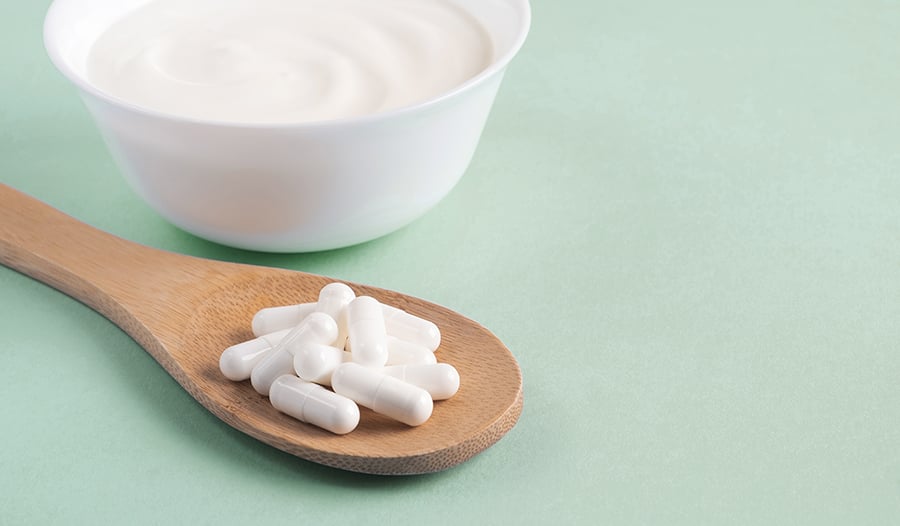Here's Why Lactoferrin, a Protein in Milk May Have Powerful Immune Health Benefits

Scientists are rediscovering some critical natural immune enhancers with the explosion of focus on enhancing immune function. Lactoferrin is one of the most fascinating. It is a biological protein essential component of colostrum — the first nourishment of mammals.
Lactoferrin is critical in nourishing and protecting newborns from infection through its immune-enhancing and antimicrobial effects. Through modern filtering technology, lactoferrin is separated from cow’s milk and made into a dietary supplement called bovine (cow) lactoferrin.
Dietary supplements providing bovine lactoferrin are available from powdered bovine colostrum. But these products vary in concentration from 0.5 to 20%. Bovine colostrum products are available that are standardized to supply 20% lactoferrin and additional bioactive compounds to support the immune system, such as naturally occurring immunoglobulins G1 & G2 (IgG1, IgG2) and proline-rich peptides (PRP). Bovine colostrum must be low heat processed to preserve the biological activity of the immunoglobulins and lactoferrin.
Over the past three decades, there has been an explosion of research into the health benefits provided by bovine colostrum and lactoferrin. This article will focus on lactoferrin’s anti-infective and immune-enhancing effects.2
What Is Lactoferrin?
Lactoferrin is a compound from milk (lactose) and can bind iron (Ferrin). Initially, researchers thought that lactoferrin played a significant role in iron absorption in newborns. However, later research showed that it does not regulate iron absorption.
Instead, when iron levels are low, lactoferrin will enhance iron absorption thereby improving iron status. And if iron stores are high, or there is an infection or inflammation, lactoferrin will sequester iron. Iron is fuel to the fire of an infection or inflammation. Iron stimulates the growth of many infecting organisms. And in inflammation, iron can generate free radicals that can damage body tissues. Lactoferrin can bind iron, keeping it from fueling both infection and inflammation.
What Does Lactoferrin Do?
Research has shown lactoferrin to exert considerable biological activity via other means than those related to iron. Here are some of the critical functions of lactoferrin (both as produced naturally in the body or taken as a supplement):2
- Regulation of iron metabolism
- Enhancement of immune function
- Antibacterial, antifungal, and antiviral properties
- Promotion of a healthy gut flora
- Antioxidant effects
One of the first things that researchers discovered was that bovine lactoferrin is converted to compounds known as lactoferricins through digestion in the human intestinal tract. These compounds are even more potent than human lactoferricins.3
Lactoferrin's Immune Support Benefits
Lactoferrin is an integral part of the innate immune system.1 It is considered a first-line defense protein that protects against infection and inflammation. And it is imperative in safeguarding against upper respiratory and gastrointestinal infection. Lactoferrin is produced by the cells that line our internal surfaces and is found primarily in mucosal secretions of the respiratory, gastrointestinal, and vaginal tract, as well as in tears. Lactoferrin is also secreted by specific white blood cells when they are activated in areas of infection.
One of the interesting aspects of lactoferrin is that it exerts a variety of immune-enhancing effects and the added benefit of reducing the excessive inflammatory response seen in many viral infections (the so-called “cytokine storm” caused by unchecked immune activation). Researchers using various animal models (i.e., rats, sheep, pigs, and cats, as well as others) as well as human clinical trials have found bovine lactoferrin has direct effects on the regulation and modulation of the immune system. In particular, lactoferrin has shown an ability to impact the number of white blood cells, especially those known as “natural killer cells,” because of their ability to kill viruses and other microbes literally. Lactoferrin also increases key mediators of white blood cell function activity and expression.1,2,4,5
In one significant human study, the effect of oral administration of bovine lactoferrin vs. placebo was evaluated in patients after surgery.6 Those taking lactoferrin showed substantial improvements (e.g., the proliferative response of white blood cells, the production of important immune system regulators, and white blood cell counts). Perhaps the most exciting result from the study was that the data presented revealed increased immune responsiveness in all patients given lactoferrin. This result is significant as it suggests that lactoferrin may help prevent the common occurrence of post-surgical infections.
Lactoferrin Is an Antimicrobial
Lactoferrin exerts antimicrobial action against many disease-causing viruses, protozoa, yeast, and bacteria. More important than actually killing organisms, maybe the recent discovery that lactoferrin prevents the attachment of disease-causing microorganisms (pathogens), including viruses, to human cells.
Lactoferrin demonstrates impressive action against virtually all types of viruses. It is truly an essential non-specific protector against viral infection. Lactoferrin inhibits viral entry into cells by primarily blocking their ability to bind to cellular receptors on the surface of host cells. Lactoferrin van also suppresses virus replication after the virus has infected the cell. This effect is very important, especially in the early stages of a viral infection.
Lactoferrin is also a powerful growth promoter of health-promoting bacteria (probiotics). By preventing the growth of harmful bacteria while promoting the growth of beneficial bifidobacteria, lactoferrin assists in the development of a healthy microbiome.
Several studies have shown that bovine lactoferrin supplementation also helps control the growth of the bacteria Helicobacter pylori in the stomach. When H. pylori overgrow in the stomach lining, it can lead to stomach irritation and digestive disturbance. In one study, 151 H. pylori-positive patients with indigestion symptoms were given either standard medical treatment known as triple therapy using an acid-blocking drug and two antibiotics alone or with lactoferrin. H. pylori status was assessed eight weeks after the supplementation period and indicated a 95.9% eradication rate for the group getting the lactoferrin. In contrast, the triple therapy group had only a 72.5% eradication rate.7
In the latest study, 400 H. pylori-positive subjects were randomized into four equal groups: (A): triple therapy for two weeks, (B): triple therapy plus another antibiotic (sequential therapy) for two weeks, (C): triple therapy plus bovine lactoferrin for two weeks, and (D): sequential therapy plus bovine lactoferrin for two weeks. The eradication rates were 70.3%, 82.8%, 85.6%, and 94.5%, respectively. The treatment success rate for the triple therapy plus lactoferrin was significantly higher than triple therapy along (85.6% vs. 70.3%). The same applied for sequential therapy plus bovine lactoferrin regimen versus sequential therapy alone (94.5% vs. 82.8).8
The clinical results clearly show bovine lactoferrin enhances the effects of triple therapy or sequential therapy for H. pylori eradication.
Clinical Trials of Bovine Lactoferrin and Upper Respiratory Tract Infections
Fourteen controlled clinical studies have evaluated bovine lactoferrin in respiratory tract infections (RTIs). Nine of these studies were recently grouped in a meta-analysis to magnify the statistical significance of the effect of lactoferrin in RTIs.9 These nine studies represented the highest quality clinical studies available.10-18
The meta-analysis revealed significantly reduced odds of developing respiratory infections with bovine lactoferrin compared to the control group. Overall, the relative risk ratio was a 43% reduction. In addition, the individual studies also showed a significant decrease of common cold and other RTI tract symptoms and duration of symptoms.
Several of these studies used bovine lactoferrin-fortified infant formulas. For example, one study conducted in Japan with children 12–32 months old showed that the intake of lactoferrin (48 mg/day)-fortified formula for 13 weeks led to a significant reduction in respiratory and gastrointestinal symptoms. The total number of days having acute respiratory symptoms in the lactoferrin group was significantly lower than the placebo group (9.0 vs. 15.0 days).11
In an even more comprehensive study, 26 infants supplemented with lactoferrin (850 mg/L) for one year experienced significantly fewer lower respiratory tract illnesses, a 66% reduction over the year compared with the 26 regular formula-fed infants.15
Adults have also benefited from bovine lactoferrin supplementation in controlled clinical trials. For example, in a study conducted in Australia, 90 subjects were given either bovine lactoferrin or a placebo for 90 days. The total number of RTIs recorded over the 90 days was 48 for the lactoferrin group versus 112 for those taking the placebo. That represents a 58% reduction in RTIs with bovine lactoferrin supplementation. The total number of symptoms of an RTI reported by participants who received bovine lactoferrin was significantly less than taking the placebo.16
Lactoferrin Dosage Considerations
The dosage of lactoferrin varies from one manufacturer to another and depends on an individual’s size and indication. Lower dosages are for general health promotion, children, and smaller individuals; higher dosages are for specific symptoms and adults. For maximum absorption, lactoferrin should be taken before meals or on an empty stomach.
Many health experts prefer bovine colostrum as the source of lactoferrin versus the highly purified product because it contains additional bioactive components, including IgGs and proline-rich peptides. If using bovine colostrum, check the lactoferrin content and dose accordingly. For example, for bovine colostrum that provides a lactoferrin content of 20%, the dosage would correspond to 500 to 1,000 mg of bovine colostrum one to three times per day.
Frequently Asked Questions About Lactoferrin
Can lactoferrin be taken if people are lactose sensitive or allergic to milk?
It depends upon the source of lactoferrin. If it is a highly purified lactoferrin product, it can be taken with confidence by people with lactose intolerance or milk allergies. If the source is colostrum, it should not be used by people sensitive or allergic to milk.
Does lactoferrin contain iron?
Again, it depends upon the source of lactoferrin. A highly purified lactoferrin product is virtually free of iron (less than 180 mcg per gram). This form of lactoferrin is called “apolactoferrin” as it is free of iron. There may be some iron if using colostrum, but it is not a significant source.
Should bovine lactoferrin be taken as a preventive measure against infection?
Supplementation with bovine lactoferrin can support non-specific host defenses and overall immune health. It can be used as a preventive whenever the immune system is challenged. The same is true for bovine colostrum.
References:
- Kell DB, Heyden EL, Pretorius E. The Biology of Lactoferrin, an Iron-Binding Protein That Can Help Defend Against Viruses and Bacteria. Front Immunol. 2020;11:1221.
- Ghosh S, Iacucci M. Diverse Immune Effects of Bovine Colostrum and Benefits in Human Health and Disease. Nutrients. 2021;13(11):3798.
- Vorland LH, Ulvatne H, Andersen J, et al. Lactoferricin of bovine origin is more active than lactoferricins of human, murine and caprine origin. Scand J Infect Dis 1998;30(5):513-7.
- Zimecki M, Wlaszczyk A, Cheneau P, Brunel AS, et al. Immunoregulatory effects of a nutritional preparation containing bovine lactoferrin taken orally by healthy individuals. Arch Immunol Ther Exp 1998;46(4):231-40.
- Yamauchi K, Wakabayashi H, Hashimoto S, et al. Effects of orally administered bovine lactoferrin on the immune system of healthy volunteers. Adv Exp Med Biol 1998;443:261-5.
- Zimecki M, Wlaszczyk A, Wojciechowski R, Dawiskiba J, Kruzel M. Lactoferrin regulates the immune responses in post-surgical patients. Arch Immunol Ther Exp 2001;49(4):325-33.
- Di Mario F, Aragona G, Dal Bo N, et al. Use of bovine lactoferrin for Helicobacter pylori eradication. Dig Liver Dis 2003;35(10):706-10.
- Hablass FH, Lashen SA, Alsayed EA. Efficacy of Lactoferrin with Standard Triple Therapy or Sequential Therapy for Helicobacter pylori Eradication: A Randomized Controlled Trial. Turk J Gastroenterol. 2021;32(9):742-749.
- Ali AS, Hasan SS, Kow CS, Merchant HA. Lactoferrin reduces the risk of respiratory tract infections: A meta-analysis of randomized controlled trials. Clin Nutr ESPEN. 2021;45:26-32. doi:10.1016/j.clnesp.2021.08.019
- Oda H, Wakabayashi H, Tanaka M, et al. Effects of lactoferrin on infectious diseases in Japanese summer: a randomized, double-blinded, placebo-controlled trial. J Microbiol Immunol Infect. 2021;54(4):566-574.
- Motoki N, Mizuki M, Tsukahara T, et al. Effects of lactoferrin-fortified formula on acute gastrointestinal symptoms in children aged 12–32 Months: a randomized, double-blind. Front Pediatr 2020 May 19;8:233.
- Li F, Wu SS, Berseth CL, et al. Improved Neurodevelopmental Outcomes Associated with Bovine Milk Fat Globule Membrane and Lactoferrin in Infant Formula: A Randomized, Controlled Trial. J Pediatr. 2019;215:24-31.
- Muscedere J, Maslove DM, Boyd JG, et al. Prevention of Nosocomial Infections in Critically Ill Patients With Lactoferrin: A Randomized, Double-Blind, Placebo-Controlled Study. Crit Care Med. 2018;46(9):1450-1456.
- Stefanescu BM, Hétu C, Slaughter JC, et al. A pilot study of Biotene OralBalance® gel for oral care in mechanically ventilated preterm neonates. Contemp Clin Trials, 35 (2013), pp. 33-39
- Chen K, Chai L, Li H, Zhang Y, Xie H-M, Shang J, et al. Effect of bovine lactoferrin from iron-fortified formulas on diarrhea and respiratory tract infections of weaned infants in a randomized controlled trial. Nutr 2016;32:222–7.
- Vitetta L, Coulson S, Beck SL, Gramotnev H, Du S, Lewis S. The clinical efficacy of a bovine lactoferrin/whey protein Ig-rich fraction (Lf/IGF) for the common cold: a double-blind randomized study. Complement Ther Med. 2013;21:164–71.
- King JC, Cummings GE, Guo L, et al. A double-blind, placebo-controlled, pilot study of bovine lactoferrin supplementation in bottle-fed infants. J Pediatr Gastroenterol Nutr 2007;44:245-251.
- Chen QP, Jiang X. Effect of lactoferrin on anemia and recurrent respiratory tract infection in preterm infants born between 34 to 36 weeks. Chin J Woman Child Health Res 2016;27:424-427.
DISCLAIMER:This Wellness Hub does not intend to provide diagnosis...













































































 Table of Contents
Table of Contents















